
October 31, 2008
Trick or treat
As a mostly Catholic country, the Philippines does not really celebrate Halloween. We observe All Saints' Day (November 1) and All Souls' Day (November 2), and many Filipinos will be trooping to the cemeteries this weekend. Many who work in Metro Manila but are from other provinces have started traveling to their hometowns this afternoon. The way Filipinos remember their dearly departed shock a lot of people from other cultures. During this weekend, our cemeteries will be like huge picnic grounds—family reunions with food and drink and children playing games. Most people will have more than one family member—extended family, not just immediate—buried in the same cemetery, so people will be walking around too, trying to visit all their loved ones. Prayers will be offered of course, but mostly, people will be telling stories about those who have passed on—especially the hilarious ones, so there will be lots of laughter too. Honestly, we're even like this during wakes (unless the death was violent or the one who died was still a child). Don't think of it as irreverent. Rather, think of it as a celebration of life—that of the one who has passed away, and that which we continue to live right now. So it's a quiet night in Metro Manila tonight. Except in some exclusive subdivisions (the term we use to refer to gated communities) which organize trick-or-treating for the children of families who live there. As a sign that a household is participating—that it has treats for the kids—the house has to be decorated for Halloween. The kids in Magallanes Village in Makati City are probably going around right now. I hope they reach this house—the family not only decorated the balcony and pedestrian gate, but the gate to the garage and even the street corner!


October 30, 2008
Point and eat
Chinese restaurants are very common in Metro Manila. One of the things I love most about them are these dim sum carts. A server goes around pushing a cart full of little bamboo steamers with different kinds of dim sum in them, you point to what you want, he puts it on your table, and marks the dim sum sheet on your table with what you got. I can have an entire meal with just dim sum—except for the chicken feet. Do you see it?


October 29, 2008
Bored
Can you imagine doing this for a living day-in and day-out? Very few pay parking buildings and lots in Metro Manila have those automatic ticket machines where you drive up to the machine, push a button, a ticket comes out and the boom goes up. Here, an attendant takes down your license plate number, hands you your ticket and pushes the button to lift the boom. At the exit, you hand your ticket and payment to another attendant in another booth. This lady is actually lucky because her little booth is enclosed and has an air-conditioner. Most do not have the luxury of the a/c and are completely exposed to the fumes of all the cars coming in and out.
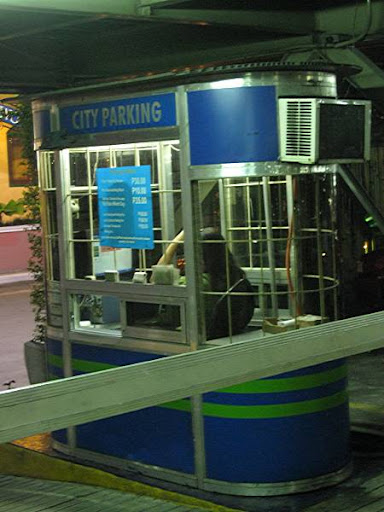

October 28, 2008
Gadget bling
October 27, 2008
Neon clock tower
Eastwood City is a 16-hectare real estate development of Megaworld Corporation near the crossroads of Quezon City, Pasig City and Marikina City. It's a high-density development with office buildings, condominium towers (currently ten), and a commercial and entertainment center which they call 'City Walk.' When non-residents like us go to the commercial center though, we just say we're going to 'Eastwood.' The place has movie theaters, a bowling alley, and a shopping and dining complex which I think is one of the most interesting in the metro, design-wise. The clock tower figures prominently in many of Eastwood City's marketing materials. It'll probably be used in the materials for that new condo going up.
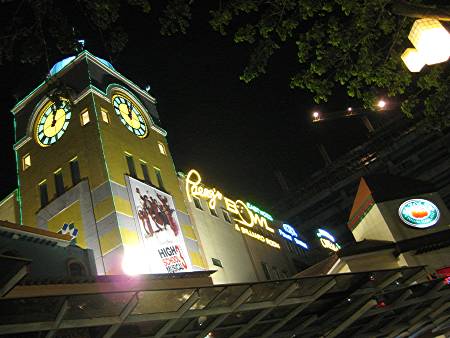
It's hard to believe that tiny little bodies can hold so much energy! It's only been two days since my sister and nieces arrived and I'm already exhausted—although in a very happy and satisfied kind of way. I'm just so glad they're not three little boys!

It's hard to believe that tiny little bodies can hold so much energy! It's only been two days since my sister and nieces arrived and I'm already exhausted—although in a very happy and satisfied kind of way. I'm just so glad they're not three little boys!
October 25, 2008
An early Christmas
The minute the 'ber' months come around, Metro Manila begins celebrating Christmas. Malls get dressed up with Christmas trees, lights and ornaments, shops display their Christmas merchandise, and everywhere you go and whatever mode of public transportation you take, cheesy pop Christmas songs blare out from speakers both mono and stereo. Personally, I don't mind the decorations, but I hate the music—and that's all I'll say about it. Anyway, there is something about our early and long Christmas season that I approve of wholeheartedly: the various projects meant to help the poor. Some are short-term, Christmas-only projects. I remember a toy shop which asked its customers to buy one extra toy to give to a child in an orphanage, which the shop would match with another toy of the same value. Then there are the long-term projects which use Christmas to try to raise both awareness and more funds, taking advantage of people's generosity (or guilt) during this season. The Children's Hour falls into the latter category. It is a fund-raising, non-profit organization which is trying to convince corporations, employees and individuals to donate at least one hour of their earnings once a year to help poor Filipino children. Now that's easy enough to do, right? The organization does not have its own projects—it gives grants to other organizations which help children. That makes a lot of sense, if you stop and think about it. The Children's Hour has a special emphasis on education and literacy, though feeding and health programs are also supported. After all, how can a child study when all he can think of is how hungry he is? I hope this box—and many others like it all over the Ayala Malls—gets filled by the end of our Christmas season on January 6, the Feast of the Epiphany.

My sister and her three young daughters are arriving tonight for a one-week visit. Wheeeee! I will still try to post a photo everyday, but I hope you will all understand if I don't get to visit much this week. I want to spend as much time as I can with my four girls. Looks like I'm also celebrating Christmas early this year.

My sister and her three young daughters are arriving tonight for a one-week visit. Wheeeee! I will still try to post a photo everyday, but I hope you will all understand if I don't get to visit much this week. I want to spend as much time as I can with my four girls. Looks like I'm also celebrating Christmas early this year.
Posted by
Hilda
14 comments:
October 23, 2008
A little sparrow too
As promised yesterday, I present to you Naomi Emmerson as Édith Piaf. Actor, singer, dancer, director, designer, Naomi was born in Montreal, Canada and lives in New York City, and has been touring Piaf: Love Conquers All for several years now. The play has "The Little Sparrow" chatting with the audience in English, reminiscing about her singing, the music, the men in her life. To highlight certain experiences, she then sings—thirteen songs in the original French. You may have noticed the piano in yesterday's photo. That was for the pianist who accompanied Naomi in the songs. Here in Manila, the pianist was Carmela Buencamino-Sinco, a Filipino who is also based in New York City. Piaf's life seems to be as poignant as her songs. Now I want to watch La Môme.
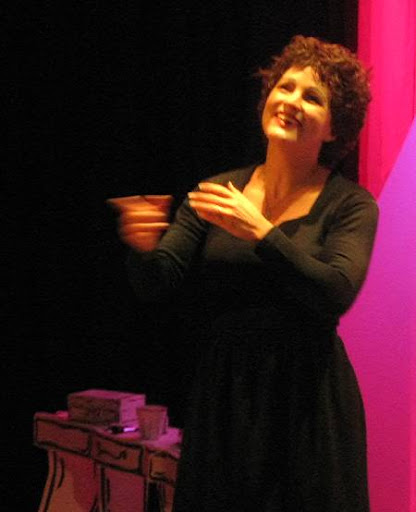

October 22, 2008
Illustrated boudoir
Finally, a theater group that didn't prohibit photos during a performance! MusicArtes' only request was for people not to use a flash. They should also have asked people to put their little digital cameras in silent mode—the fake shutter sound of the camera of the lady behind me was irritating. I couldn't bring myself to take photos during the performance though—I didn't want to miss any of the lines or songs in Piaf: Love Conquers All, a one-person drama about the life and music of Édith Piaf. It had four shows in Metro Manila, staged at the Francisco Santiago Hall in Makati City. Tomorrow, I will introduce you to the very talented woman who acted and sang for two hours, and designed the costumes and this wonderfully quirky, illustrated set.
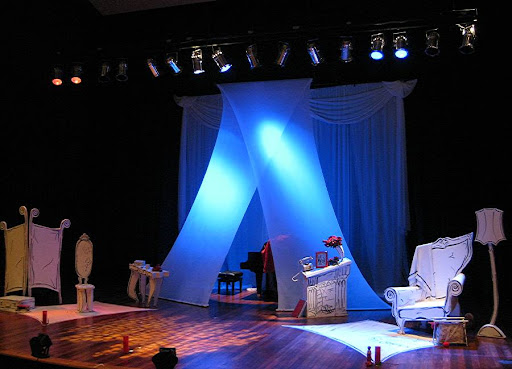

October 21, 2008
Portrait or caricature?
Waiting for the theater Onstage to open its doors, I saw these two artists creating portraits and caricatures from photographs at the base of the escalator.


Posted by
Hilda
12 comments:
Labels:
art
October 20, 2008
Women
Since the year 2000, the Ateneo de Manila University has experienced a flurry of landscaping—among other, more serious matters, of course. This is especially true of the spaces between buildings which used to be covered only with crabgrass. Now, flowers, rock gardens and charming paths beautifully set off the campus' gorgeous trees. Earlier this month, traditionally the month of Mary for Catholics, a Marian walk between Gonzaga Hall and Berchmans Hall was blessed.
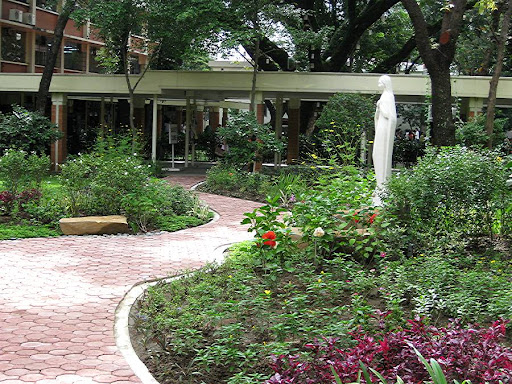
Mary, especially in her form as the Immaculate Conception, is the patroness of this Jesuit university. She is usually depicted with the moon at her feet, though I've seen versions with clouds or cherubs and various combinations of these three elements.
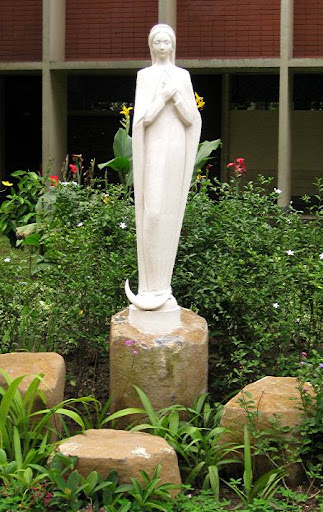
2000 was the year when the university's School of Arts and Sciences was split off into four schools (Humanities, Science and Engineering, Social Sciences, Management), each with its own dean, and all under the Vice President for the Loyola Schools. The first VP was Dr. Anna Miren Intal and the current VP is Dr. Maria Assunta Cuyegkeng.

Mary, especially in her form as the Immaculate Conception, is the patroness of this Jesuit university. She is usually depicted with the moon at her feet, though I've seen versions with clouds or cherubs and various combinations of these three elements.

2000 was the year when the university's School of Arts and Sciences was split off into four schools (Humanities, Science and Engineering, Social Sciences, Management), each with its own dean, and all under the Vice President for the Loyola Schools. The first VP was Dr. Anna Miren Intal and the current VP is Dr. Maria Assunta Cuyegkeng.
Posted by
Hilda
15 comments:
October 19, 2008
Golden prow
Intrigued by the bangka that rowed across my sunset photo last Friday, I followed it as it crossed the harbor of the Manila Yacht Club. Here are some of the sailboats docked there. The tall building in the background is the 1322 Golden Empire Tower, a residential condominium along Roxas Boulevard. Its main boast is that every unit has a view of Manila Bay. It is currently the tallest building in the City of Manila, and the fourth tallest in Metro Manila. At 203 meters, it's downright puny compared to the world's tallest building.
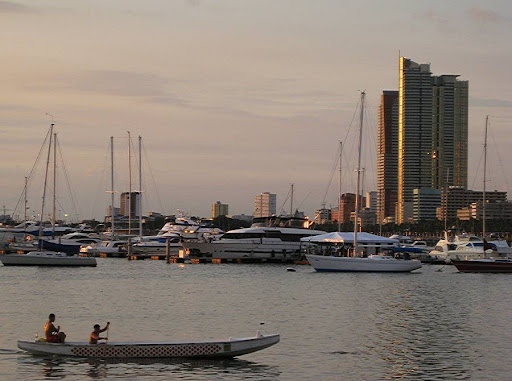

October 17, 2008
Among bigger cousins
I was trying to get a photo of the sunset across the breakwater that protects the Manila Yacht Club when these two guys in a little bangka (canoe) rowed past. Now I'm forever left wondering where they came from—the breakwater extends all the way to the shore on that end—and what they were doing.



Visit the Sky Watch Friday home page and tour the skies of our beautiful world.

October 16, 2008
Circles and lines
The current decoration in the atrium of The Podium, one of two upscale malls in the Ortigas Center. Simple and elegant. I'm glad they didn't decorate for Halloween—some of the shops and restaurants did, and that's enough.
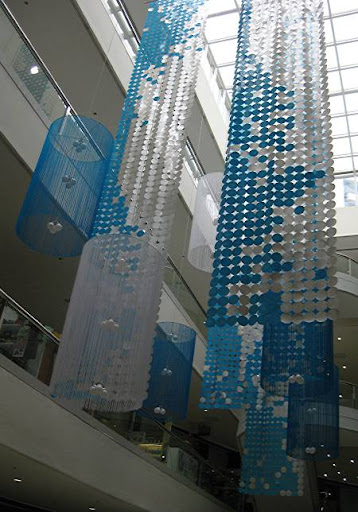

October 15, 2008
Power struggle
The Manila Electric Company, better known as Meralco, is the only power distributor in Metro Manila. In fact, it is the only power distributor in almost half of Luzon, the largest island in the Philippines. It was set up in 1903 by an entrepreneur from Detroit mainly to operate Manila's electric tramway system, with power generation and distribution only as an extension of the transportation business ('Meralco' comes from the company's original name: Manila Electric Railroad and Light Company). During WWII, the company's assets were seized by the Japanese. In 1962, Eugenio Lopez Sr. bought the company and it became Filipino-owned for the very first time. In 1972, when Ferdinand Marcos declared Martial Law, the government again forcibly seized control of Meralco and it was returned to the Lopez family only after the People Power Revolution in 1986. This year, there is another struggle for control of the power company—between the Lopez family and the Government Service Insurance System, one of the major stock holders of Meralco. Accusations are being hurled all over the place and, for a time, it was always front page news. The news may have moved on to the next big thing, but I don't think the power struggle has been resolved yet. The simple but elegantly curved building is the building most associated with Meralco and is located in the company's large complex in the Ortigas Center.
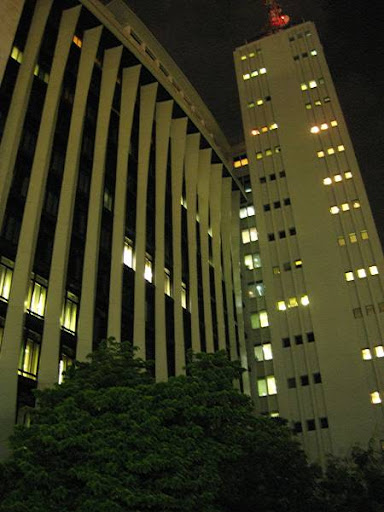

October 14, 2008
Amusing
This is the front of the funny-looking building I posted yesterday. It's the entrance of the Aliw Theater, and I'm sure you all see the letters. Aliw is a Tagalog word which means entertainment, amusement. Most of the performances staged here are popular concerts, although it is also the main performance venue of Ballet Manila. I still say the building looks strange and gaudy. Okay, only on the outside, but still…


October 13, 2008
Spiky skyline
Right beside the elegant Cultural Center of the Philippines in Pasay City is a building which houses the radio station DZRH and the Aliw Theater. To tell you the truth, I already think that the building is horrendous and it's made even more so by that… that thing! I have no idea what it is. I always thought that it was just some attention-getting devise of Star City, an amusement park farther down the road. But the more I look at it, the more it looks like a radio antenna tower dressed up for Christmas. Or is it Halloween?
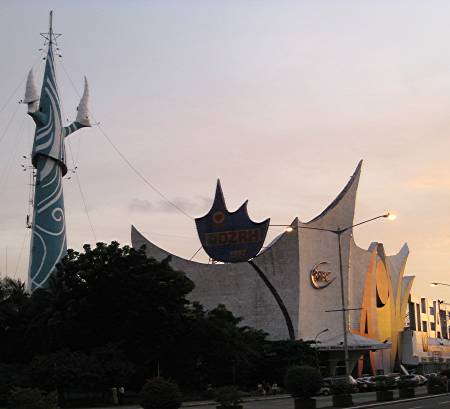


Find more Odd Shots—or post your own—at Katney's Kaboodle.

October 12, 2008
Opa!
I've always maintained that Metro Manila is a foodie's heaven. One can easily eat out everyday in a different restaurant for an entire year, and I'm not counting branches of the same restaurant or the many holes-in-the-wall found throughout the metro. Cyma is a Greek restaurant that first opened its doors in Boracay Island, which has some of the Philippines' most famous and popular beaches. It now has three branches in Metro Manila: at Shangri-la Mall in Mandaluyong, Trinoma Mall in Quezon City, and Greenbelt 2 in Makati City. Executive Chef Robby Goco supposedly traveled all over Greece and the Mediterranean sampling and studying the dishes of the region for Cyma. I don't know how authentic the flavors are, but I have to say that I haven't eaten anything in Cyma that didn't taste great. Some dishes I like better than others, of course, but it's more a matter of personal preference than anything about the food itself. I'm a cheese fiend and would also rather have fish and seafood, so I'm not a good judge of meat dishes. I was with a self-confessed carnivore when we had this Paidakia: char-grilled lamb ribs. Cyma's servings are large—even the solo size—so we shared this, after an appetizer of Saganaki: flaming cheese. The lamb was served with Patates Fournou: potatoes marinated in lemon, garlic, oregano and extra-virgin olive oil, roasted, then topped with freshly grated Parmesan cheese.


October 10, 2008
Sunset cruise
This is the boat used for the daily sunset cruise of Manila Bay. An overcast sky does not discourage people.



Visit the Sky Watch Friday home page and tour the skies of our beautiful world.

October 9, 2008
Glorious wood
As a Catholic university, the Ateneo de Manila has several chapels aside from the Church of the Gesù which I've featured during the day and at night. One of my favorite chapels is the Immaculate Conception Chapel in the Loyola Schools. It was redesigned extensively in 2000 by architect Vincent Pinpin and looks very different from when we used to attend Sunday mass there when I was a kid. I love the simplicity of the chapel now, with all its beautiful wood, big windows at the sides to let in lots of sunlight, and the few panes of colored glass up front behind the altar. The crucifix rotates and on the other side is the resurrected Christ, used during the Easter season. The small statue of Mary is a replica of a bigger one which is probably as old as the university. The original statue used to stand in the grand staircase of the Intramuros campus in the late 1800s. It either survived the 1930s fire and transfered to the entrance of the Padre Faura campus, or there was a second statue exactly like the first one. I don't know if I can ever find out for sure, but I do know that the Padre Faura statue was mostly destroyed during WWII. However, the upper portion was salvaged and when the university moved to Loyola Heights in Quezon City in the 1950s, the statue was restored by an alumni class that studied in the Padre Faura campus. That restored statue is now kept in the university archives.
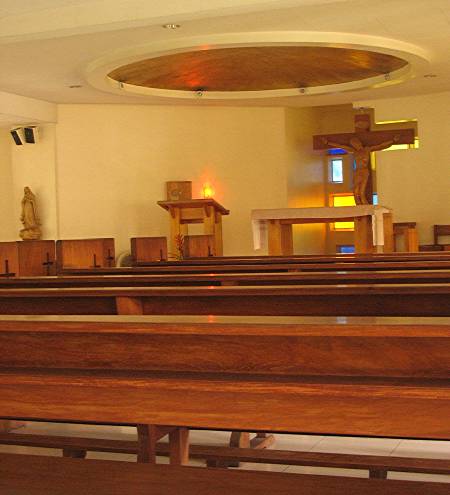

October 8, 2008
October 7, 2008
Centennial
Since I mentioned Jose Rizal in my previous two posts, I might as well add a third and get him out of my system. Because he's a Philippine national hero, his image and name appears all over the country, especially in monuments and street names, whether he actually went to the place or not. Here, we see a bust of him through the gates of Palma Hall in the Diliman campus of the University of the Philippines (U.P.). When I was in college and visiting friends here, Palma Hall was the home of the College of Arts and Letters. Now, according to U.P. Diliman's website, it is the College of Social Sciences and Philosophy. We used to be able to pass through this gate too. I think it's permanently closed now, and only the gates at its sides are left open. My guess is it's to preserve Rizal's bust—you know what college kids can be like. U.P. was founded in June 18, 1908 and this year marked their centennial. Their official seal is composed of an eagle holding a shield with symbols for agriculture (inside the pyramid: a coconut tree, rows in a field, and something tied in a bundle), science (upper left: a book, an oil lamp with a flame, and a funny-looking flask which I remember from Chemistry lab), and engineering (upper right: a hammer, an anvil, and a wheel). At least, those are the symbols in this seal. Wikipedia has a picture of the seal on the gate of U.P.'s main library, and it sure looks different from this one. And it's the image on the library that was used when U.P. had its seal redrawn and registered in the Intellectual Property Office.


October 6, 2008
What does a basement look like?
And what's a theater post from me without a sneaky photograph? I showed you the posters of Dulaang U.P.'s "Isang Panaginip na Fili" yesterday. Here is the one-shot-only photo of the stage. [I really have to start remembering to change my camera's settings before we enter theaters!] Rizal began writing El Filibusterismo in 1887 when he was still in the Philippines but continued working on it while he was in Europe, finally finishing it in 1891. The play sets him in Paris, living in the basement of a friend's apartment. I think the set designer went a little overboard though—this looks more like a sewer than a basement! But I guess I can understand the exaggeration. Since most Filipino homes don't have basements, the designer wanted to make sure that the audience understood that Rizal was writing his second novel in a less-than-ideal environment.


October 5, 2008
Keep on dreaming, Pepe
Philippine national hero Dr. Jose P. Rizal and his two novels Noli Me Tangere and El Filibusterismo seem to be popular topics not just in history and literature classes here but also in plays. In August, we watched the Philippine Educational Theater Association's "Noli at Fili: Dekada 2000," a modern interpretation of the two novels, and the same theater group is currently staging "Batang Rizal," which discusses the ideas of heroism and nationalism from the point of view of children, one of whom is the child Jose "Pepe" Rizal. Dulaang U.P., the resident theater group of the state University of the Philippines, recently staged "Isang Panaginip na Fili" (A Dream of Fili). Basically, the play is just a dramatization of Rizals' entire second novel. What makes it different is the fact that it is a musical, and the novel's story is interspersed with scenes where Pepe discusses his novel-in-progress with a friend. In the end, they differ in their ideas about how Pepe should end his novel. Tunying wants him to choose the way of weapons and warfare. But Pepe—much like his other choices in life—in the end decides to reject violence. It's a slower and more difficult path, and many of the social ills of the Philippines that Rizal wrote about still exist to this day. But, as the play exhorts in the end: Keep on dreaming, Pepe, and maybe one of these days, your dream of justice, freedom and equality for Filipinos just might come true. Especially if enough Filipinos dream with him, I think.


October 4, 2008
My Manila
There is a reason why I titled my blog "My Manila" and never changed it even after it was accepted into the City Daily Photo community. Metro Manila is composed of 17 cities and municipalities, after all, and I move in only a tiny part of it. And I mean that in both the geographical sense and, much as I hate to admit it, also in an economic sense. The World Bank estimates that 40% of Filipinos live in poverty. And if the World Fact Book's July 2008 population estimate is correct, that's a whopping 38.4 million people! In Metro Manila, the hard fact of poverty can be seen in large squatter communities, homeless people sleeping under bridges and in parking lots at night, and men, women and children selling flowers, candies, cigarettes and rag rugs on the streets. Unfortunately (or fortunately, depending on your point of view), these are things I have had no opportunity to take pictures of—for various reasons which will take too long to explain—though I know I have hinted at it several times already. Here, finally, is more than a hint: a man rooting through garbage bags to get boxes, cans and bottles that he can sell to a recycling center. I wonder if he even makes 40 pesos a day doing this…


October 2, 2008
An artist's mangrove
Filipino artist Impy Pilapil, best known for her glass and stone sculptures, has had an interactive installation in the campus of the Ateneo de Manila University since February titled "Interactive: 12 Human Senses." Aside from providing a lovely touch of color to the grounds, it was actually fun playing with them. My favorites were two musical pieces. I'm speaking in the past tense because I discovered last week that they're being removed one by one. First to go was "Music Chamber," my favorite. I used a friend's photo of it to illustrate an April post in my other blog. This photo shows the bamboo "Chime Halo," the second of my favorites, and the showcase piece "The Mangrove – Nature's Embrace." I took this photo last week and when I passed by the area early this week, the colorful mangrove was gone. I'm going to miss them.


Posted by
Hilda
15 comments:
October 1, 2008
Graffitied wall
THEME DAY: LINES • I've featured Bookay-ukay, the used-books store near our home, a couple of times, during their opening day and about two months after that. This is the first time I'm showing their nuclear green, graffiti-as-you-will wall. Most of the art is line drawings but a few photographs have made their way onto it. And if you can't find a book that interests you, you just might find some lines of text here that will.

It's fun seeing the different ways CDP bloggers interpret the month's theme. Some are literal, some artistic, some witty, some downright cheeky. Click here to view thumbnails for all participants.

It's fun seeing the different ways CDP bloggers interpret the month's theme. Some are literal, some artistic, some witty, some downright cheeky. Click here to view thumbnails for all participants.
Subscribe to:
Posts (Atom)

